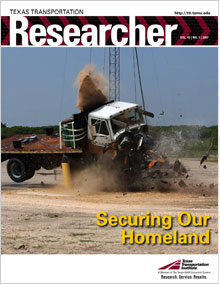 Between 1970 and 2002, the volume of United States overseas trade more than doubled. It’s expected to double again by 2016. How do goods enter the United States? Ninety-nine percent of it moves through U.S. ports. With 367 miles of coastline and 29 ports, the state of Texas is now facing the daunting task of securing its ports—and the people and freight moving through them every day.
Between 1970 and 2002, the volume of United States overseas trade more than doubled. It’s expected to double again by 2016. How do goods enter the United States? Ninety-nine percent of it moves through U.S. ports. With 367 miles of coastline and 29 ports, the state of Texas is now facing the daunting task of securing its ports—and the people and freight moving through them every day.
A recent study for the Southwest Region University Transportation Center (SWUTC) examined the effects of new security measures on port infrastructure development and finances. Texas Transportation Institute (TTI) researchers examined nine Texas public ports, which accounted for 88 percent of the foreign cargo moving through Texas ports in 2003. From this analysis, the team identified several policy issues at the federal level that ports face:
- how best to allocate limited funds to maximize security,
- how to distribute funds fairly so as to prevent a competitive imbalance,
- how to ensure that all ports meet a minimum level of security,
- how much financial responsibility the federal government should assume for security infrastructure,
- how the federal government and ports will deal with ever-increasing costs as more security projects are completed, and
- who will pay to replace worn-out or obsolete equipment.
“The federal government gives the ports grants to fund security infrastructure,” says Jim Kruse, the director of the Center for Ports and Waterways at TTI. “It also sets general goals for security and leaves it up to the ports to decide how they achieve those goals.”
For example, one goal may be to secure the perimeter of the port. The port may choose cameras, fences, boats, intelligent motion detectors and/or even underwater sensors. Port officials at many ports in the state express concern that the federal investment in security is not great enough to address the need. While the Port Security Grant Program pays for security equipment, it also stipulates that the ports must pay for maintenance and operation. “Anywhere from 3 to 16 percent of ports’ operating revenues go to maintenance of security measures, like normal wear and tear,” says Kruse.
The research team identified alternate security financing measures. Among the variations currently being debated and implemented are:
- Various port charges – Ports on the East and Gulf Coast have begun adding security surcharges as high as 10 percent on dockage and wharfage.
- Department of Homeland Security (DHS) appropriations – Thus far, most of the federal government’s financial participation has been through appropriations for DHS.
- Earmark customs fees – A certain percentage of duties collected on articles transported by vessel and unloaded for purposes of entering the customs territory of the U.S. could be set aside for security improvements.
- Federal security fees – Several bills have been introduced that would establish federal user fees to help offset the costs of security at the national level.
Ultimately, continuing to find ways to keep ports secure and operating efficiently can only strengthen Texas’ homeland security efforts.
